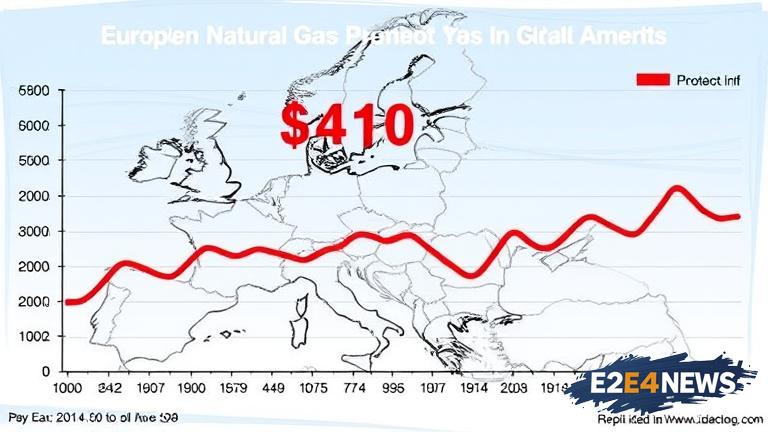The natural gas market in Europe has witnessed a substantial decline in prices, with the current rate falling below $410. This downturn can be attributed to several factors, including a decrease in global demand, particularly from major consumers such as China and the United States. The reduction in demand has led to an oversupply of natural gas in the European market, resulting in lower prices. Furthermore, the increased production of liquefied natural gas (LNG) from countries like the United States and Qatar has also contributed to the surplus. The European Union’s efforts to diversify its energy sources and reduce dependence on Russian gas have also played a role in the price drop. Additionally, the mild winter season in Europe has led to lower consumption of natural gas for heating purposes, further contributing to the decline in prices. The current price of natural gas in Europe is a significant decrease from the record highs seen in 2022, when prices soared due to the Russian-Ukrainian conflict and subsequent sanctions. The drop in prices is expected to have a positive impact on the European economy, as lower energy costs will lead to increased competitiveness and reduced inflation. However, the decline in prices may also have negative consequences for natural gas producers, who may see reduced revenue and profitability. The European natural gas market is expected to remain volatile in the coming months, with prices potentially fluctuating based on global demand and supply. The International Energy Agency (IEA) has forecasted that natural gas demand will continue to grow in the coming years, driven by increasing consumption in emerging economies. Nevertheless, the current price drop is a welcome relief for European consumers, who have been facing high energy costs in recent years. The decline in natural gas prices is also expected to have a positive impact on the environment, as lower prices may lead to increased adoption of natural gas as a cleaner alternative to coal and oil. In conclusion, the drop in natural gas prices in Europe below $410 is a significant development, driven by a combination of factors including decreased global demand, increased supply, and diversification of energy sources. As the global energy landscape continues to evolve, it is likely that natural gas prices will remain volatile, with potential fluctuations based on changing demand and supply dynamics. The European natural gas market will likely continue to be influenced by global events, including geopolitical tensions, weather patterns, and shifts in energy policy. The current price drop is a positive development for European consumers and the environment, but may have negative consequences for natural gas producers. The future of the natural gas market in Europe will depend on a variety of factors, including the development of new energy sources, changes in global demand, and the impact of climate change policies. As the world transitions towards a lower-carbon economy, the role of natural gas will likely continue to evolve, with potential opportunities for growth and development in emerging economies. The decline in natural gas prices is also expected to have a positive impact on the European manufacturing sector, as lower energy costs will lead to increased competitiveness and reduced production costs. The current price drop is a significant development in the European energy market, with potential implications for the economy, environment, and energy policy. In the coming months, it is likely that natural gas prices will continue to fluctuate based on global demand and supply, with potential opportunities for growth and development in emerging economies.





